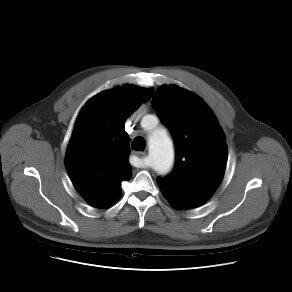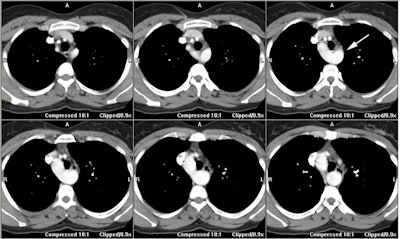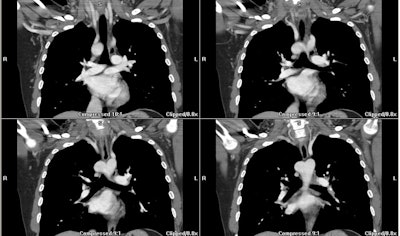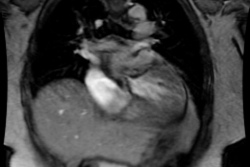Aberrant Subclavian Artery and Right Aortic Arch:
Left Arch with Aberrant Right Subclavian:
- Clinical:This is the most common congenital vascular anomaly of the aortic
arch
(present in about 0.5 to 2% of the population) [3]. The right
subclavian artery
arises just distal to left subclavian artery as the last branch of
the
aortic arch (beyond the ligamentum arteriosum) and runs to the
right POSTERIOR
to the esophagus (this produces a posterior indentation from lower
left
to upper right on barium esophagram). Patients with trisomy 21
have a high prevalence of this anomaly (up to 35%) [3]. Most
patients are asymptomatic, but approximately 10% of adults with
this anomaly have symptoms of dysphagia due to extrinsic
esophageal compression- termed dysphagia lusoria [3].
In 15-30% of cases the aberrant right subclavian artery will arise from a diverticulum of Kommerell (a wide based out-pouching) and in this anomaly there is a completed loose vascular ring due to a persistent right-sided ductus arteriosus or ligamentum arteriosum which arises from the junction between the diverticulum and the normal sized subclavian artery [3]. Affected patients are more likely to develop dysphagia.
- X-ray:
On the CXR the aberrant right subclavian artery can be seen as an edge along its interface with the lung, running from the left side immediately above the aortic knob, across the midline to the right superior mediastinum. On the lateral view, there may be obscuration of the posterior aspect of the aortic arch by the aberrant vessel (ie: the lung will not outline that portion of the aortic arch) [1].
|
Left aortic arch with aberrant right subclavian artery: The CT image below demonstrates an aberrant right subclavian artery arising as the last branch from the aortic arch. In this case the vessel is not arising from a diverticulum. The vessel travels to the right posterior to the esophagus. |
|
|
Left Arch with Isolated Right Subclavian:
- Clinical:This is a rare condition in which the right common carotid, left
common
carotid, and left subclavian vessels arise normally from the arch,
but
the right subclavian does not arise from right common carotid
artery- in
fact, there is a discontinuity between these two vessels. The
isolated
right subclavian fills in a retrograde fashion as blood flows
around the
circle of Willis and down the right vertebral artery which
produces a congenital
subclavian steal syndrome. The right subclavian may maintain a
connection
to the right pulmonary artery via a right ductus/ ligamentum
arteriosus.
Left circumflex aorta:
- Clinical:
This anomaly is extremely rare [3]. There is a left sided aortic
arch with an aberrant right subclavian artery, however, in this
anomaly the arch itself crosses the midline posterior to the
esophagus, rather than the aberrant right subclavian artery
crossing the midline [3]. The right ductus arteriosus or
ligamentum arteriosum connects the right pulmonary artery to the
descending aorta forming a vascular ring [3].
Right Aortic Arch with Mirror Image Branching (Type I Right Arch):
- Clinical/X-ray:Two major forms of right sided aortic arch exist- mirror image branching (type I) and right arch with an aberrant left subclavian (type II). Mirror image branching right arch is less common and results from interruption of the embryonic left arch between the left subclavian artery and the descending aorta, usually dorsal to the left ductus. It is almost always (98%) associated with congenital heart disease- nearly always cyanotic and most commonly tetrology of Fallot (about 75% of affected patients) [1,2]. A left inominant artery is the first vessel to arise from the aorta and it crosses anterior to the trachea. A right common carotid artery is the next vessel, followed by a right subclavian artery. Because the left ductus arteriosus connects the left subclavian artery portion of the left inominant artery to the left pulmonary artery, there is no vascular ring and NO posterior indentation on the esophagus (rarely, a vascular ring may be created if there is a left ductus connecting the upper descending aorta to the left pulmonary artery).
Tetrology of Fallot which is the most common congenital heart disease seen in association with a right arch and pateints will be cyanotic. About 25% of patient with tetrology of Fallot have a right arch and 90% of these will have a mirror image branching pattern. The remaining 10% have an aberrant left subclavian and may not present until adulthood. Other forms of congenital heart disease are also associated with a right arch including truncus arteriosus- about 30% of patients with truncus have a right arch and they will also be cyanotic.
Right Arch with Aberrant Left Subclavian (Type II Right Arch):
- Clinical:A right aortic arch occurs in approximately 0.1% of adults [2]. Type II right arch results from the interruption of the hypothetical double aortic arch between the left common carotid and left subclavian arteries. An aberrant left subclavian artery is the most common abnormality associated with a right arch [2,3] and it is rarely symptomatic. The aberrant left subclavian artery is derived from the fourth branch of the posterior aortic arch at the junction of the right arch and the descending aorta. The aberrant left subclavian artery commonly arises from a diverticulum of Kommerell which creates a loose vascular ing [3]. There is a slightly increased association with other cardiac anomalies (5-15% of cases have associated congenital cardiac abnormalities) including tetrology of Fallot (70%), left to right shunts, and coarctation of the aorta (7%), (although other authors indicate associated CHD is rare, unless the diverticulum of Kommerell is not present [3]). The major vessels arise from the aorta in the following order- left common carotid artery, right common carotid artery, right subclavian artery, and the aberrant left subclavian artery [1].
- X-ray:
On angiography, the left subclavian arises as the last vessel from the arch and crosses from right to left posterior to the esophagus. It will produce a posterior impression on the air or barium filled esophagus or trachea. The vessel typically arises from a large diverticulum off the aortic arch (diverticulum of Kommerall) which is usually found to the left and slightly below the usual site of a left sided aortic arch. The divertiulum may be large enough to produce a bulge above the left main pulmonary artery and may simulate a left arch or mediastinal mass. A left ductus arising from the diverticulum (the presence of a diverticulum of Kommerall implies a left ligamentum arteriosum [2]) or the left subclavian artery to the left pulmonary artery will form a complete vascular ring encircling both the trachea and the esophagus. However, most patients with this configuration are asymptomatic indicating that the ring is quite loose [2].
|
Right aortic arch with aberrant left subclavian artery: The CT image below demonstrates an aberrant left subclavian artery arising as the last branch from the aortic arch. In this case the vessel is arising from a diverticulum (white arrow). |
|
|
|
Right aortic arch with aberrant left subclavian artery: In another patient with a right arch the left subclavian artery arises as the last branch from a large diverticulum (white arrow) |
|
|
Right Arch with Isolated Left Subclavian:
- Clinical:A rare anomaly which is similar to the isolated right subclavian
syndrome.
The condition occurs when the left 4th embryonic aortic arch
regresses between the left common carotid and the left subclavian
arteries, as well as between the ligamentum arteriosum and the
descending aorta [2]. The left subclavian can be supplied by the
left pulmonary artery via a patent ductus arteriosus [2]. If the
ductus is closed, the subclavian is supplied by the left vertebral
artery and produces a congenital subclavian steal. The condition
is associated with CHD in over half of the cases, most commonly
tetralogy of Fallot [3].
- X-ray:
On angiography the left subclavian artery is connected to the left pulmonary artery by the left ductus, but lacks any communication with the aorta.
Right aortic arch with left descending aorta:
- Clinical:
This is an uncommon variant of right aortic arch that is sometimes referred to as a circumflex aorta or retroesophageal aortic segment [2]. In the anomaly, the transverse arch courses posterior to the esophagus and continues as a left descending aorta [2]. A symptomatic vascular ring can be formed in the setting of an aberrant left subclavian artery and a ligamentum arteriosum [2].
|
Right aortic arch with left descending aorta (retroesophageal aortic arch): The patient shown below had originally undergone chest CT for evaluation of an abnormal CXR. The CT exam demonstrates a retroesophageal aortic arch (right arch with left sided descending aorta- black arrows). The first vessel arising from the arch was a left inominant (white arrow). Despite the severe tracheal compression, the patient was asymptomatic. |
|
|
Cervical aortic arch:
- Clinical:
A cervical aortic arch is a rare anomaly that usually occurs on the right side (>80%) and is thought to be the result of persistence of the third embryologic aortic arch or failure of the fourth embryologic arch to descend [2]. The anomaly is usually associated with unusual origins of the internal and external carotid arteries and the descending aorta is usually contralateral to the arch [2]. Cervical arch can present with a pulsatile neck mass or upper airway obstruction [2].
REFERENCES:
(1) J Thorac Imag 1995; 10: 1-25
(2) J Cardiovasc Comput Tomogr 2010; Kanne JP, Godwin JD. Right
aortic arch and its variants. 4: 293-300
(3) Radiographics 2017; Hanneman K, et al. Congenital variants
and anomalies of the aortic arch. 37: 32-51













